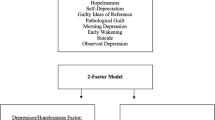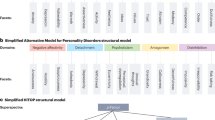Abstract
Objective
We tested Kraepelin’s dichotomy model by studying the separability of schizophrenia and depression on the basis of symptoms and illness course.
Materials and methods
Matched untreated patients with schizophrenia and depression (n = 130 each) and 130 “healthy” controls were assessed from onset to first admission. In a second study the same variables were studied in 107 patients with schizophrenia over a homogenised follow-up of 134 months (11.2 years).
Results
The symptom most frequently marking the onset of both schizophrenia and depression was depressive mood. Both disorders exhibited the same prodromal core syndrome. It was not until the emergence of positive symptoms that the disorders became separable by the international classification systems. Depression remained the most frequent syndrome over the entire course of schizophrenia.
Conclusion
Depression does not represent comorbidity, but an integral part of psychosis. A dimensional disease model based on successively emerging hierarchical symptom patterns, not unknown to the later Kraepelin, is offered as an explanation.










Similar content being viewed by others
References
Achard S, Salvador R, Whitcher B, Suckling J, Bullmore E (2006) A resilient, low-frequency, small-world human brain functional network with highly connected association cortical hubs. J Neurosci 26:63–72
Addington D, Addington J, Patten S (1998) Depression in people with first-episode schizophrenia. Br J Psychiatry 172:90–92
Alonso J, Angermeyer MC, Bernert S, Bruffaerts R, Brugha TS, Bryson H, de Girolamo G, Graaf R, Demyttenaere K, Gasquet I, Haro JM, Katz SJ, Kessler RC, Kovess V, Lepine JP, Ormel J, Polidori G, Russo LJ, Vilagut G, Almansa J, Arbabzadeh- Bouchez S, Autonell J, Bernal M, Buist-Bouwman MA, Codony M, Domingo-Salvany A, Ferrer M, Joo SS, Martinez-Alonso M, Matschinger H, Mazzi F, Morgan Z, Morosini P, Palacin C, Romera B, Taub N, Vollebergh WA (2004) Prevalence of mental disorders in Europe: results from the European study of the epidemiology of mental disorders (ESEMeD) project. Acta Psychiatr Scand Suppl 420:21–27
Andreasen NC (1983) The scale for the assessment of negative symptoms (SANS). University of Iowa, Iowa City
Angst J (1980) Verlauf unipolar depressiver, bipolar manisch-depressiver und schizo-affektiver Erkrankungen und Psychosen. Ergebnisse einer prospektiven Studie. Fortschr Neurol Psychiatr Grenzgeb 48:3–30
Angst J, Scharfetter C, Stassen HH (1983) Classification of schizo-affective patients by multidimensional scaling and cluster analysis. Psychiatr Clin 16:254–264
Biehl H, Maurer K, Jablensky A, Cooper JE, Tomov T (1989) The WHO Psychological Impairments Rating Schedule (WHO/PIRS). I. Introducing a new instrument for rating observed behaviour and the rationale of the psychological impairment concept. Br J Psychiatry 155(Suppl. 7):68–70
Black K, Peters L, Rui Q, Milliken H, Whitehorn D, Kopala LC (2001) Duration of untreated psychosis predicts treatment outcome in early psychosis program. Schizophr Res 47:215–222
Breier A, Schreiber JL, Dyer J, Pickar D (1991) National Institute of Mental Health longitudinal study of chronic schizophrenia: prognosis and predictors of outcome. Arch Gen Psychiatry 48:239–246
Bressan RA, Chaves AC, Pilowsky LS, Shirakawa I, Mari JJ (2003) Depressive episodes in stable schizophrenia: critical evaluation of the DSM-IV and ICD-10 diagnostic criteria. Psychiatry Res 117:47–56
der an Heiden W, Krumm B, Müller S, Weber I, Biehl H, Schäfer M (1995) Mannheimer Langzeitstudie der Schizophrenie. Nervenarzt 66:820–827
der an Heiden W, Könnecke R, Maurer K, Ropeter D, Häfner H (2005) Depression in the long-term course of schizophrenia. Eur Arch Psychiatry Clin Neurosci 255:174–184
Goldberg TE, David A, Gold JM (2003) Neurocognitive deficits in schizophrenia. In: Hirsch SR, Weinberger D (eds) Schizophrenia. 2nd edn. Blackwell, Oxford, pp 168–184
Häfner H, an der Heiden W (2003) Course and outcome of schizophrenia. In: Hirsch SR, Weinberger DR (eds) Schizophrenia, 2nd edn. Blackwell, Oxford, pp 101–141
Häfner H, Riecher-Rössler A, Hambrecht M, Maurer K, Meissner S, Schmidtke A, Fätkenheuer B, Löffler W, an der Heiden W (1992) IRAOS: an instrument for the assessment of onset and early course of schizophrenia. Schizophr Res 6:209–223
Häfner H, Maurer K, Löffler W, Riecher-Rössler A (1993) The influence of age and sex on the onset and early course of schizophrenia. Br J Psychiatry 162:80–86
Häfner H, Maurer K, Löffler W, an der Heiden W, Munk-Jφrgensen P, Hambrecht M, Riecher-Rössler A (1998a) The ABC schizophrenia study: a preliminary overview of the results. Soc Psychiatry Psychiatr Epidemiol 33:380–386
Häfner H, an der Heiden W, Behrens S, Gattaz WF, Hambrecht M, Löffler W, Maurer K, Munk-Jørgensen P, Nowotny B, Riecher-Rössler A, Stein A (1998b) Causes and consequences of the gender difference in age at onset of schizophrenia. Schizophr Bull 24:99–113
Häfner H, Maurer K, Löffler W, an der Heiden W, Stein A, Könnecke R, Hambrecht M (1999a) Onset and prodromal phase as determinants of the course. In: Gattaz WF, Häfner H (eds) Search for the causes of schizophrenia, vol. IV: balance of the century. Steinkopff, Darmstadt, pp 35–58
Häfner H, Löffler W, Maurer K, Riecher-RösslerA, Stein A (1999b) IRAOS. Interview für die retrospektive Erfassung des Erkrankungsbeginns und –verlaufs bei Schizophrenie und anderen Psychosen. Hans Huber Verlag, Bern
Häfner H, Löffler W, Maurer K, Riecher-Rössler A, Stein A (2003) IRAOS—Interview for the retrospective assessment of the onset and course of schizophrenia and other psychoses. Hogrefe & Huber, Göttingen
Häfner H, Maurer K, Ruhrmann S, Bechdolf S, Klosterkötter J, Wagner M, Maier W, Bottlender R, Möller H-J, Gaebel W, Wölwer W (2004) Early detection and secondary prevention of psychosis: facts and visions. Eur Arch Psychiatry Clin Neurosci 254:117–128
Häfner H, Maurer K, Trendler G, an der Heiden W, Schmidt M, Könnecke R (2005) Schizophrenia and depression: challenging the paradigm of two separate diseases -a controlled study of schizophrenia, depression and healthy controls. Schizophr Res 77:11–24
Harrison G, Hopper K, Craig T, Laska E, Siegel C, Wanderling J, Dube KC, Ganev K, Giel R, an der Heiden W, Holmberg SK, Janca A, Lee PWH, Leon CA, Malhotra S, Marsella AJ, Nakane Y, Sartorius N, Shen PW, Skoda C, Thara R, Tsirkin SJ, Varma VK, Walsh D, Wiersma Y (2001) Recovery from psychotic illness: a 15 and 25 year international follow-up study. Br J Psychiatry 178:506–517
Jackson H (1887) Remarks on evolution and dissolution of the nervous system. J Ment Sci 33:25–48
Jung E, Krumm B, Biehl H, Maurer K, Bauer-Schubart C (1989) Mannheimer Skala zur Einschätzung von sozialer Behinderung (DAS-M). Beltz, Weinheim
Kahlbaum KL (1874) Die Katatonie oder das Spannungsirresein. Hirschwald, Berlin
Kendell RE, Brockington IF (1980) The identification of disease entities and the relationship between schizophrenic and affective psychoses. Br J Psychiatry 137:324–331
Köhn D, Niedersteberg A, Wieneke A, Bechdolf A, Pukrop R, Ruhrmann S, Schultze-Lutter F, Maier W, Kloskterkötter J (2003) Frühverlauf schizophrener Ersterkrankungen mit langer Dauer der unbehandelten Erkrankung – eine vergleichende Studie. Fortschr Neurol Psychiatr 71:1–5
Kraepelin E (1896) Psychiatrie, 5th edn. Barth, Leipzig
Kraepelin E (1904) Psychiatrie, Bd 2: Klinische Psychiatrie, 7. Aufl. Barth, Leipzig
Kraepelin E (1920) Die Erscheinungsformen des Irreseins. Zschr Ges Neurol Psychiat 62:1–29
Maier W (2006) Do schizoaffective disorders exist at all? Acta Psychiatr Scand 113:369–371
Manchanda R, Norman A, Malla R, Harricharan S Northcott S (2005) Persistent psychoses in first episode patients. Schizophr Res 80: 113–116
Marneros A, Deister A, Rohde A, Steinmeyer EM, Jünemann H (1989a) Long-term outcome of schizoaffective and schizophrenic disorders: A comparative study. Part I: definitions, methods, psychopathological and social outcome. Eur Arch Psychiatry Neurol Sci 238:118–125
Marneros A, Steinmeyer EM, Deister A, Rohde A, Jünemann H (1989b) Long-term outcome of schizoaffective and schizophrenic disorders: a comparative study. III: Social consequences. Eur Arch Psychiatry Neurol Sci 238:135–139
Marneros A, Deister A, Rohde A (1991) Affektive, schizoaffektive und schizophrene Psychosen. Springer, Berlin
Maurer K, Trendler G, Schmidt M, an der Heiden W, Könnecke R, Häfner H (2006) Schizophrenie und depression. Nervenarzt 77:809–822
Möller H-J (2005) Antipsychotic and antidepressive effects of second generation antipsychotics. Eur Arch Psychiatry Clin Neurosci (Special Issue) 255:190–201
Möller H-J, v Zerssen D (1986) Der Verlauf schizophrener Psychosen unter den gegenwärtigen Behandlungsbedingungen. Springer, Berlin
Riedel O, Dodel R, Spottke A, Deuschl G, Förstl H, Henn F, Heuser I, Oertel W, Reichmann H, Riederer P, Trenckwalder C, Wittchen H-U (2006) Wie beurteilen Ärzte die HÄufigkeit demenzieller, depressiver und psychotischer Symptome bei Patienten mit der Parkinson-Krankheit? Eine Befragung von 500 FachÄrzten im ambulanten Versorgungssektor Deutschlands. Akt Neurol 33:374–380
Schulze TG, Ohlraum S, Czerski PM, Schumacher J, Kassem I, Deschner M, Gross M, Tullius M, Heidman V, Kovalenko S, Jamra RA, Becker T, Leszcynska-Rodziewicz A, Hauser J, Illig T, Klopp N, Wellek S, Chichon S, Henn FA, McMahon FJ, Maier W, Propping P, Nothen MM, Rietschel M (2005) Genotype studies in bipolar disorder showing association between the DAOA/G30 locus and persecutory delusions: a first step toward a molecular genetic classification of psychiatric phenotypes. Am J Psychiatry 162:2101–2108
Selten J-P, Veen N, Feller W, Blom JD, Kahn R, Schols D, Camoenië W, Oolders J, van der Velden M, Hoek HW, Vladár-Rivero VR, van der Graaf Y (2001) Incidence of psychotic disorders in immigrant groups to the Netherlands. Br J Psychiatry 178:367–372
Stefanis N, Hanssen M, Smirnis N, Avramopoulos D, Evdokimidis I, Stefanis CN, Verdoux H, van Os J (2002) Evidence that three dimensions of psychosis have a distribution in the general population. Psychol Med 32:347–358
Sydenham T (1742) Observationes medicare (1676). In: Swan J (eds) The entire works of Thomas Sydenham, newly made English from the originals. Cave, London
Tsuang MT, Fleming JA (1987) Long-term outcome of schizophrenia and other psychoses. In: Häfner H, Gattaz WF, Janzarik W (eds) Search for the causes of schizophrenia. Springer, Berlin, pp 88–97
Van Os J, Verdoux H, Maurice-Tison S, Gay B, Liraud F, Salamon R, Bourgeois M (1999) Self-reported psychosis-like symptoms and the continuum of psychosis. Soc Psychiatry Psychiatr Epidemiol 34:459–463
Wiersma D, Wanderling J, Dragomirecka E, Ganev K, Harrison G, an der Heiden W, Nienhuis FJ, Walsh D (2000) Social disability in schizophrenia: its development and prediction over 15 years in incidence cohorts in six European centres. Psychol Med 30:1155–1167
Wing JK, Cooper JE, Sartorius N (1974) Measurement and classification of psychiatric symptoms: an instruction manual for the PSE and CATEGO Program. Cambridge University Press, London
Wittchen H-U, Höfler M, Lieb R, Spauwen J, van Os J (2004) Depressive und psychotische Symptome in der Bevölkerung – Eine prospektiv-longitudinale Studie (EDSP) an 2.500 Jugendlichen und jungen Erwachsenen. Paper presented at the DGPPN Congress, Berlin, 24–27 Nov 2004 (Abstract published in Nervenarzt 75: Suppl. 2:87)
World Health Organization (1988) Psychiatric disability assessment Schedule, Geneva, WHO
Disclosure
The authors have no conflict of interest to declare.
Author information
Authors and Affiliations
Corresponding author
Additional information
Paper presented at the Letten Foundation symposium “Emil Kraepelin’s dichotomy—was it true? Kraepelin’s contribution to psychiatry”, commemorating Kraepelin’s 150 birthday—30 April 2007, Munich
Rights and permissions
About this article
Cite this article
Häfner, H., an der Heiden, W. & Maurer, K. Evidence for separate diseases?. Eur Arch Psychiatry Clin Neurosc 258 (Suppl 2), 85–96 (2008). https://doi.org/10.1007/s00406-008-2011-4
Published:
Issue Date:
DOI: https://doi.org/10.1007/s00406-008-2011-4




